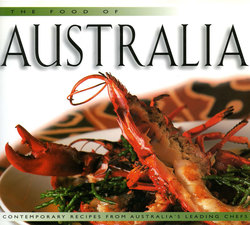Читать книгу Food of Australia (H) - Wendy Hutton - Страница 14
На сайте Литреса книга снята с продажи.
ОглавлениеThe Great Aussie Barbie
Alfresco dining is a national institution
by Tony Baker
Australia stands alone among the nations of the world in having launched a tourism boom with a barbecue. Back in 1983, actor Paul Hogan appeared in TV commercials designed to entice Americans to Australia, which wound up with him at a barbecue saying in his familiar Aussie drawl "C'mon. C'mon 'n' say g'day. I'll slip an extra shrimp on the barbie." It was stupendously successful because it captured the easygoing hedonism of the sunburnt country.
Australians have made an art form of eating outdoors. It is rare to find an Australian house without a barbecue, and even a city apartment is likely to have one on the balcony. The main roads, parks, beaches and picnic areas have public barbecue facilities. When the eating out boom began in the 1970s, among its earliest manifestations were pubs with beer gardens where customers bought and cooked their own steaks with salads and sauces on an adjacent buffet. When two Australian men stop talking about sport, there is a good chance they are busy swapping their secret recipes for the perfect marinade.
There is, though, much more to Australians' love affair with their great outdoors. It can be said that before the evolution of today's creative cuisine, there was a, much earlier indigenous style known as "bush tucker," built around a billy can on an open fire or, more recently, a camp oven. Today's new wave chefs make ingenious and appetizing use of Australia's unique flora and fauna, but they are only following on the inventiveness or necessity of those hardy 19th-century shearers, drovers and diggers who learned how to cook kangaroo, quandongs (wild peaches), emu, wild goat and even camel in basic conditions. These were eaten with damper, a simple bread of flour, water, milk or beer with butter and oil, perhaps flavored with native herbs and cooked in a billy or bush oven on an open fire. Today's chic city restaurants often serve a sophisticated version of damper to an appreciative clientele. Bush tucker has been refined in a most glamorous way in the Red Centre, beneath the MacDonnell Ranges outside Alice Springs, where restaurateur Ron Tremaine provides billy tea, damper, bush salad and Territory beef served under the stars—an experience not to be forgotten. I think the original Australian joke is the "bushman's recipe for cooking cockatoo. Catch a cockatoo and boil it with two stones. When the stones are soft, the bird is ready. Another version commands you to throw away the cockatoo and eat the stones. Another bush recipe calls for 3 medium-sized camels, 700 bushels of vegetables, 1,000 gallons of gravy and 2 small rabbits. You are directed to spend several months preparing and simmering the stew, which will serve 3,800; if more people are expected, add the 2 rabbits.
The traditional bush camp, a necessity for drovers and travelers in the early days, is now included in tour operators' packages in parts of Australia.
Thanks to its climate, eating out around Australia is also a mass affair. Rare is the Australian event, from the running of the Melbourne Cup to the Adelaide arts festival, which does not feature outdoor eating, usually around a "barbie," perhaps a picnic or that sturdy Australian staple, meat pie with tomato sauce.
When Victoria embarked on a tourism promotion campaign, the promoters did so with the world's longest lunch at which hundreds of people sat down to seafood on a long pier. There are now at least a dozen regional wine and food festivals in which premier restaurants set up in wine cellar doors for a day or weekend and people travel the district for a glass of wine and plate of food at each.
Despite the national passion for the outdoors, it is only in recent years that what seems the most obvious way of enjoying this has caught on. Australia's liquor licensing laws and local council regulations once made pavement or boulevard eating and drinking impossible. Battle was joined and won and today, entire city streets from Fremantle in Western Australia to the tourist belts of Queensland are now lined with tables and chairs. That alfresco feeling is also an integral part of many frontline restaurants. Where once the backyard was the place for the empties, today it is likely to be a shaded garden with foodies taking their ease. When making a booking at an Australian restaurant, it's wise to check the weather forecast and then inquire whether there is an outdoor option.
The final touch to any Aussie barbecue is a handful of gum leaves in the fire for that dinky di (authentic) outback flavor
The national partiality for eating outdoors has perhaps also contributed to Australians' longevity. From bush tucker to barbies, Australians have learned the simple pleasures of the plain grill and taught themselves to be inventive when devising salads, Paul Hogan's shrimp on the barbie was a health as well as a lifestyle statement.
